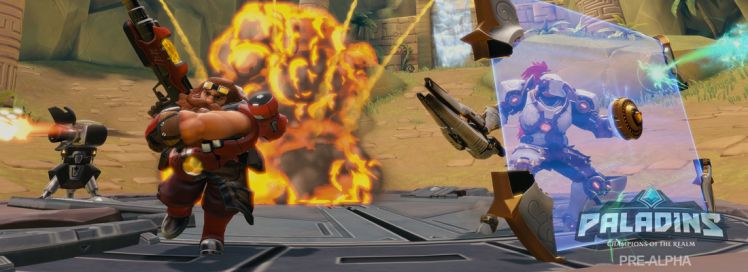GamesBeat: Since we’re going into more of an art direction conversation, what was the color philosophy you adopted for the characters? What are you doing to make them be seen clearly? Did you run with characters only being in a certain color palette or maybe environments should only be cool colors? These are things to consider since you’re going for visual simplicity.
Newbrough: Right. Yeah! I mean, we considered a lot of that. If you look at [this character], she seems to have a color scheme that’s similar to this map here.
We actually have two maps here, ones an enchanted forest with sort of brown brushy vines. So she blends in really well with that … but a lot of this has to do with the outline. If you look, there’s a faint blue line around the allies and a red outline on the enemy characters.
We did a lot of work on that. In fact, it probably took us about two months to isolate exactly how we wanted to do the outline system so that every character pops out from the background. We also did a lot of map adjustments so things popped the way we wanted them to.
GamesBeat: Yeah. I see. So, what did you design before this?
Newbrough: Smite
GamesBeat: Smite. OK. And …?
Newsbrough: …
GamesBeat: … is that your only game?
Newbrough: Right, right. No. These are the only two titles I’ve worked on.
GamesBeat: What did you do on Smite?
Newbrough: God design, game balance, maps, a little bit of flow design there as well.
GamesBeat: But you were designing before that, right? Maybe doing some personal projects on your own?
Newbrough: No. Smite was the first.
GamesBeat: Really? So, what’s your background before Smite?
Newbrough: So, I’ve done basically everything. Product management, international relations — I’ve traveled around the world selling games. I’ve done some esports casting as well, getting to understand the competitive scenes and what pros like. Then I moved directly into game design from there.
But my background is in competition and understanding what that means and also meeting with people who are not necessarily competitive players … it really gives me a wide spectrum for what players actually want.
Also, before I became the game designer [for Paladins], I was helping with Smite. You know, “the strong characters are too strong, the weak characters are too weak … and then balancing them.”
You know, I was doing that for about a year. It’s just very natural for me.
VentureBeat's mission is to be a digital town square for technical decision-makers to gain knowledge about transformative enterprise technology and transact. Learn More


